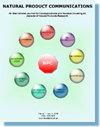基于指纹图谱和网络药理学的风阴汤中大黄q标记预测分析
IF 1.4
4区 医学
Q4 CHEMISTRY, MEDICINAL
引用次数: 1
摘要
风阴汤(FYD)是一种治疗癫痫和风麻痹的中药。然而,大黄(FYD中最有效的中药)中潜在的抗癫痫活性成分尚未明确。本研究基于指纹图谱和网络药理学对大黄在FYD中的潜在质量标记(Q-marker)进行了分析和预测。建立黄芪和大黄的指纹图谱,分析其有效成分的传递规律。采用超高效液相色谱法(UPLC)对不同提取方法得到的枸杞子有效成分进行了定量研究。结合网络药理学分析,构建“成分-靶点-通路”网络,预测潜在的q标记物。通过红外指纹图谱鉴定出芦荟大黄素、大黄素、大黄素、大黄酚、桂皮醛、6-姜辣素、甘草酸铵盐等8个峰。不同提取方法对大黄蒽醌中8种有效成分的测定表明,大黄蒽醌可能是一种潜在的抗癫痫有效成分。通过网络药理学方法筛选出大黄的12个核心成分、19个靶点和21条通路,进一步证明大黄主要通过这些成分、靶点和通路发挥作用。初步预测大黄蒽醌类化合物是潜在的q标记物。本研究建立的UPLC指纹图谱及8种成分的含量测定方法有效可行。本研究结果可为进一步研究黄芪的质量控制提供参考,并为研究黄芪的作用机制奠定理论基础。此外,本研究还可为其他经典复方中药q标记的研究提供新的思路。本文章由计算机程序翻译,如有差异,请以英文原文为准。
Q-marker Prediction Analysis of Rhubarb in Fengyin Decoction Based on Fingerprint and Network Pharmacology
Fengyin Decoction (FYD) is a traditional Chinese medicine for the treatment of epilepsy and wind paralysis. However, the potential antiepileptic active component in rhubarb (which is the most effective Chinese medicine in FYD) has not been defined. In this study, we analyzed and predicted the potential quality marker (Q-marker) of rhubarb in FYD based on fingerprint and network pharmacology. The fingerprints of FYD and rhubarb were established to analyze the transmission law of active components. Ultra-high performance liquid chromatography (UPLC) was used to study quantitatively the active components obtained by different extraction methods of FYD. Combined with network pharmacological analysis, a “components-targets-pathways” network was constructed to predict the potential Q-marker. Eight peaks were identified by FYD fingerprint: aloe-emodin, rhein, emodin, chrysophanol, physcion, cinnamaldehyde, 6-gingerol, and glycyrrhizic acid ammonium salt. The determination of the 8 active components in FYD with different extraction methods suggested that rhubarb anthraquinone may be a potential antiepileptic active component. Twelve core components, 19 targets, and 21 pathways of rhubarb were screened by network pharmacology, which further demonstrated that rhubarb played a role mainly through these components, targets, and pathways. We preliminarily predicted that compounds such as rhubarb anthraquinones were a potential Q-marker. The UPLC fingerprint and the content determination method of the 8 components established in this study were effective and feasible. The findings in this study may provide a reference for further study of quality control of FYD and lay a theoretical foundation for the study of its action mechanism. In addition, our study may provide a novel idea for the study of the Q-marker of other classical compound traditional Chinese medicines.
求助全文
通过发布文献求助,成功后即可免费获取论文全文。
去求助
来源期刊

Natural Product Communications
工程技术-食品科技
CiteScore
3.10
自引率
11.10%
发文量
254
审稿时长
2.7 months
期刊介绍:
Natural Product Communications is a peer reviewed, open access journal studying all aspects of natural products, including isolation, characterization, spectroscopic properties, biological activities, synthesis, structure-activity, biotransformation, biosynthesis, tissue culture and fermentation. It covers the full breadth of chemistry, biochemistry, biotechnology, pharmacology, and chemical ecology of natural products.
Natural Product Communications is a peer reviewed, open access journal studying all aspects of natural products, including isolation, characterization, spectroscopic properties, biological activities, synthesis, structure-activity, biotransformation, biosynthesis, tissue culture and fermentation. It covers the full breadth of chemistry, biochemistry, biotechnology, pharmacology, and chemical ecology of natural products.
Natural Product Communications is a peer reviewed, open access journal studying all aspects of natural products, including isolation, characterization, spectroscopic properties, biological activities, synthesis, structure-activity, biotransformation, biosynthesis, tissue culture and fermentation. It covers the full breadth of chemistry, biochemistry, biotechnology, pharmacology, and chemical ecology of natural products.
 求助内容:
求助内容: 应助结果提醒方式:
应助结果提醒方式:


